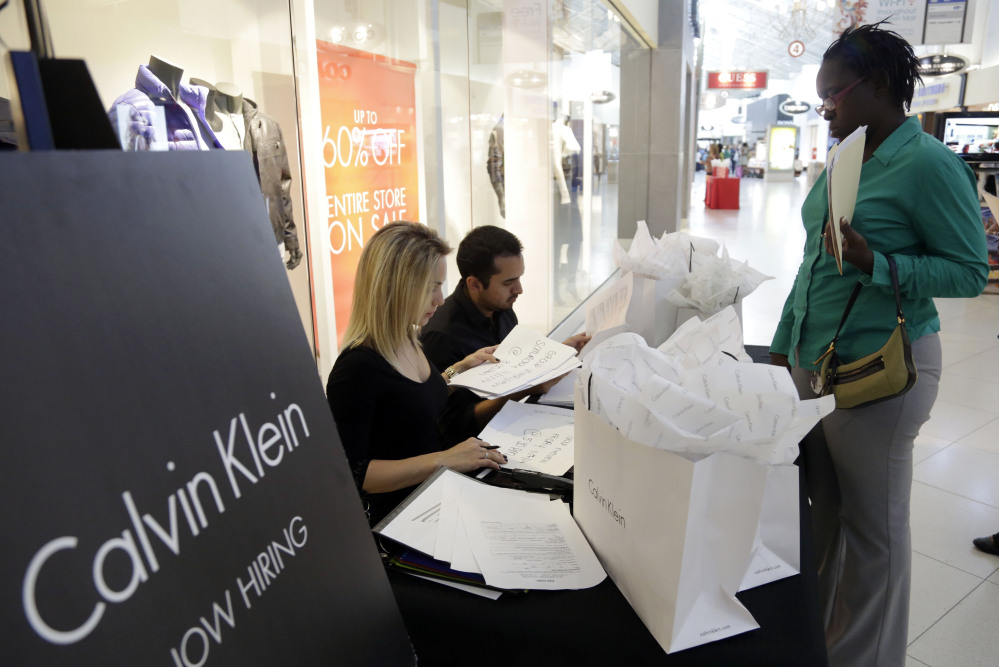WASHINGTON — Healthy job growth in the United States has reached a level of consistency unseen in nearly two decades.
In the same week that voters signaled discontent with the U.S. economy, the government issued a report that showed employers have added at least 200,000 jobs for nine straight months – the longest such stretch since 1995.
Combine it with an unemployment rate that has slid to 5.8 percent – the lowest since 2008 – and the picture that emerged Friday was of a job market gaining increasing distance from the recession that officially ended nearly 51/2 years ago.
The job gain for October was a solid 214,000, on top of a combined 31,000 more in August and September than the government had previously estimated.
The steady improvement contrasts with the struggles of economies overseas, a key reason the Federal Reserve is withdrawing its stimulus just as other central banks ramp up theirs. This week, for example, the European Central Bank opened the door wider for further help for a eurozone economy that may be on the brink of another recession.
The U.S. job market is hardly without its own weaknesses. Americans’ average hourly pay rose only slightly last month, a negative note in an otherwise solid report. Stagnant wages have been a chronic weakness in the job market since the recession ended.
Voters listed the economy as their top concern in Tuesday’s elections, and the sluggish pace of pay growth was a likely factor. Average hourly pay rose 3 cents in October to $24.57. That’s just 2 percent above the average wage 12 months earlier and barely ahead of a 1.7 percent inflation rate.
Some economists say, though, that they’re seeing early signs of rising pay, especially as more jobs emerge in higher-paying sectors. If so, more workers could begin to enjoy thicker paychecks in coming months. A broad measure of pay and fringe benefits, which captures bonus pay that the jobs report’s gauges miss, has risen in the past six months at its fastest pace since 2008.
“We think that there is plenty of evidence to suggest that … wage growth is accelerating,” said Paul Ashworth, an economist at Capital Economics.
The U.S. unemployment rate fell in October even as more Americans began looking for work. That suggests that more out-of-work people were encouraged by the brightening jobs picture.
“This was a great month for the American labor market,” said James Marple, an economist at TD Bank. “The U.S. job engine is not just chugging along, it is gaining speed.”
Pay gains in some industries are outpacing the national average. For workers in the hotel, restaurant and entertainment industry, hourly pay has risen 3.5 percent in the past year. Retail pay has risen 2.6 percent. So has construction pay.
And hiring has increased in middle- and higher-paying industries, a change from earlier in the recovery. Job gains have picked up in construction, manufacturing, professional and business services, and government.
Economists say the rising U.S. economy – the world’s largest – is unlikely to provide much spillover help to sputtering economies overseas. Though the U.S. economy accounts for one-fifth of global output, Europe and Japan face major hurdles to faster growth. These include aging populations, crushing government debt and heavily regulated job markets.
“It helps at the margin, but it’s not going to do enough to turn around those economically depressed regions,” Sal Guatieri, an economist at BMO Capital Markets, said of the improving U.S. economy.
Analysts say the economic expansion remains strong enough to support the current pace of hiring. Over the past six months, the economy has grown at a 4.1 percent annual rate.
XPOLogistics, a shipping company, has hired 250 people in the past three months and has 300 open jobs. The company connects manufacturers, retailers and other firms that need shipping with independent trucking firms. It has opened a new office in Kansas City, Missouri, where it plans to hire 125 people.
Scott Malat, the company’s chief strategy officer, said that rising manufacturing output has helped drive growth.
“The economy has been better, and that plays right into our hands,” he said.
Analysts say the economic expansion remains strong enough to support the current pace of hiring. Over the past six months, the economy has grown at a 4.1 percent annual rate.
U.S. manufacturers are expanding at the fastest pace in three years, according to a survey by the Institute for Supply Management, a trade group. A measure of new orders showed that factory output will likely continue to grow in coming months. A separate survey by the ISM found that retailers, restaurants and other service companies also grew at a healthy pace last month.
Home sales rose in September at their fastest rate this year, a sign that housing could pick up after a sluggish performance for most of this year.
Still, faltering global growth could create trouble for the U.S. economy in the months ahead. Exports fell in September, the government said this week, widening the trade deficit. That led many economists to shave their predictions of economic growth in the July-September quarter to an annual rate of 3 percent or less, down from the government’s initial estimate of 3.5 percent.
Send questions/comments to the editors.



Success. Please wait for the page to reload. If the page does not reload within 5 seconds, please refresh the page.
Enter your email and password to access comments.
Hi, to comment on stories you must . This profile is in addition to your subscription and website login.
Already have a commenting profile? .
Invalid username/password.
Please check your email to confirm and complete your registration.
Only subscribers are eligible to post comments. Please subscribe or login first for digital access. Here’s why.
Use the form below to reset your password. When you've submitted your account email, we will send an email with a reset code.